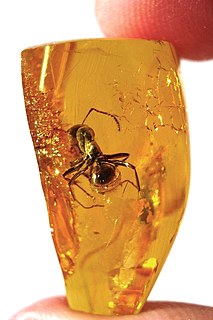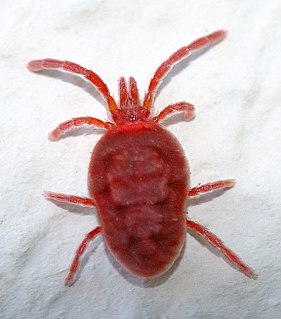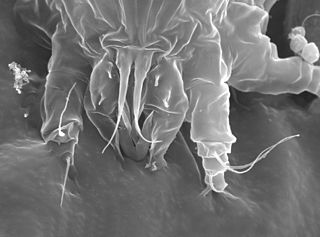Related Research Articles

Amber is fossilized tree resin that has been appreciated for its color and natural beauty since Neolithic times. Much valued from antiquity to the present as a gemstone, amber is made into a variety of decorative objects. Amber is used in jewelry. It has also been used as a healing agent in folk medicine.

Bees are winged insects closely related to wasps and ants, known for their role in pollination and, in the case of the best-known bee species, the western honey bee, for producing honey. Bees are a monophyletic lineage within the superfamily Apoidea. They are presently considered a clade, called Anthophila. There are over 16,000 known species of bees in seven recognized biological families. Some species – including honey bees, bumblebees, and stingless bees – live socially in colonies while most species (>90%) – including mason bees, carpenter bees, leafcutter bees, and sweat bees – are solitary.

Scabies is a contagious skin infestation by the mite Sarcoptes scabiei. The most common symptoms are severe itchiness and a pimple-like rash. Occasionally, tiny burrows may appear on the skin. In a first-ever infection, the infected person will usually develop symptoms within two to six weeks. During a second infection, symptoms may begin within 24 hours. These symptoms can be present across most of the body or just certain areas such as the wrists, between fingers, or along the waistline. The head may be affected, but this is typically only in young children. The itch is often worse at night. Scratching may cause skin breakdown and an additional bacterial infection in the skin.

The family Dipluridae, known as curtain-web spiders are a group of spiders in the infraorder Mygalomorphae, that have two pairs of booklungs, and chelicerae (fangs) that move up and down in a stabbing motion. A number of genera, including that of the Sydney funnel-web spider (Atrax), used to be classified in this family but have now been moved to Hexathelidae.

The Cupedidae are a small family of beetles, notable for the square pattern of "windows" on their elytra, which give the family their common name of reticulated beetles.

Myxophaga is the second-smallest suborder of the Coleoptera after Archostemata, consisting of roughly 65 species of small to minute beetles in four families. The members of this suborder are aquatic and semiaquatic, and feed on algae.

Eudimorphodon was a pterosaur that was discovered in 1973 by Mario Pandolfi in the town of Cene, Italy and described the same year by Rocco Zambelli. The nearly complete skeleton was retrieved from shale deposited during the Late Triassic, making Eudimorphodon one of the oldest pterosaurs known. It had a wingspan of about 100 centimeters (3.3 ft) and at the end of its long bony tail may have been a diamond-shaped flap like in the later Rhamphorhynchus. If so, the flap may have helped it steer while maneuvering in the air. Eudimorphodon is known from several skeletons, including juvenile specimens.

The Acariformes, also known as the Actinotrichida, are the most diverse of the two superorders of mites. Over 32,000 described species are found in 351 families, with an estimated total of 440,000 to 929,000 species, including undescribed species.

Parasitiformes are a superorder of Arachnids, constituting one of the two major groups of mites, alongside Acariformes. Parasitiformes has, at times, been classified at the rank of order or suborder.

Opilioacaridae is the sole family of mites in the order Opilioacarida, made up of about 13 genera. The mites of this family are rare, large mites, and are widely considered primitive, as they retain six pairs of eyes, and abdominal segmentation. They have been historically been considered separate from other mites belonging to Acariformes and Parasitiformes, but are now generally considered a subgroup of Parasitiformes based on molecular phylogenetics.

Eriophyoidea are a superfamily of herbivorous mites. All post-embryonic instars lack the third and fourth pairs of legs. The respiratory system is also absent.

The Ommatidae are a family of beetles in the suborder Archostemata. The Ommatidae are considered the extant beetle family that has most ancestral characteristics. There are only seven extant species, confined to Australia and South America. However, the geographical distribution was much wider during the Mesozoic spanning across Eurasia and Australia, suggesting that they were widespread on Pangea. So far, 28 extinct genera containing over 100 species of these beetles have been described. Three extant genera have been assigned to this family: Omma,Tetraphalerus and Beutelius. The family is considered to be a subfamily of Cupedidae by some authors, but have been found to be more closely related to Micromalthidae in molecular phylogenies. A close relationship with Micromalthidae is supported by several morphological characters, including those of the mandibles and male genitalia. Due to their rarity, their ecology is obscure, it is likely that their larvae feed on deadwood.
Blomosuchus is an extinct genus of archosauriform from the Early Triassic of Russia. The type species was named in 1992 as Blomia georgii. However, the name Blomia was preoccupied by a genus of mites in the family Glycyphagidae (Blomia), so the genus was renamed Blomosuchus in 1997. Fossils of Blomosuchus have been found along the Vetluga River besides fossils of another problematic archosauriform, Vonhuenia.
The Carnian pluvial episode (CPE), often called the Carnian pluvial event, was an interval of major changes in global climate and the dominant plants and animals, or biota, of Earth that occurred during the Carnian age of the late Triassic period. It occurred over several million years, across the boundary between the Julian and Tuvalian subages of the Carnian. It led to the evolution and diversification of many important groups of life, including the first dinosaurs, lepidosaurs, and calcium-containing microfossils, as well as a wider array of conifers and stony corals. The CPE also led to the extinction of many aquatic invertebrate species, especially among the ammonoids, conodonts, bryozoa, and crinoids.
Ampezzoa triassica is an extinct species of gall mite described from the Carnian of northeastern Italy. It lived as a parasite of Cheirolepidiaceae trees. The only known specimen, preserved in amber, is 0.124 mm long. It resembles very much, in body shape and wax secretions, the contemporary gall mite Cymeda zealandica. Along with Triasacarus fedelei and an unnamed dipteran, it is the oldest arthropod found enclosed in amber.
Triasacarus fedelei is an extinct species of gall mite described from the Carnian of northeastern Italy. It lived as a parasite of Cheirolepidiaceae trees. The only known specimen, preserved in amber, is 0.210 mm long. Along with Ampezzoa triassica and an unnamed dipteran, it is the oldest arthropod found enclosed in amber.
This list of fossil arthropods described in 2014 is a list of new taxa of trilobites, fossil insects, crustaceans, arachnids and other fossil arthropods of every kind that have been described during the year 2014. The list only includes taxa at the level of genus or species.
This list of fossil arthropods described in 2015 is a list of new taxa of trilobites, fossil insects, crustaceans, arachnids and other fossil arthropods of every kind that have been described during the year 2015. The list only includes taxa at the level of genus or species.
This list of fossil arthropods described in 2012 is a list of new taxa of trilobites, fossil insects, crustaceans, arachnids and other fossil arthropods of every kind that have been described during the year 2012. The list only includes taxa at the level of genus or species.
This list of fossil arthropods described in 2018 is a list of new taxa of trilobites, fossil insects, crustaceans, arachnids, and other fossil arthropods of every kind that were described during the year 2018, as well as other significant discoveries, and events related to arthropod paleontology that are scheduled to occur in the year 2018.
References
- ↑ Ekaterina A. Sidorchuk; Alexander R. Schmidt; Eugenio Ragazzi; Guido Roghi; Evert E. Lindquist (2015). "Plant-feeding mite diversity in Triassic amber (Acari: Tetrapodili)". Journal of Systematic Palaeontology. 13 (2): 129–151. doi:10.1080/14772019.2013.867373. S2CID 85055941.
- 1 2 "Archived copy". Archived from the original on 6 August 2019. Retrieved 3 January 2015.
{{cite web}}: CS1 maint: archived copy as title (link)